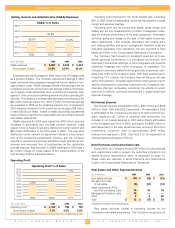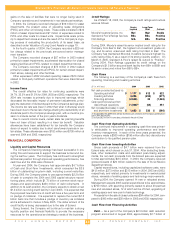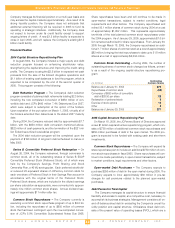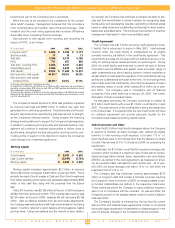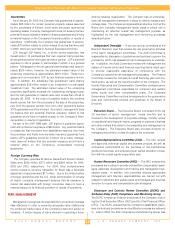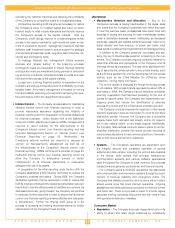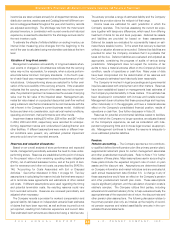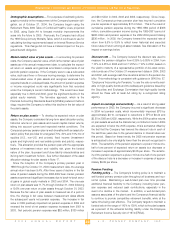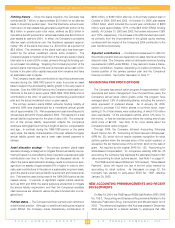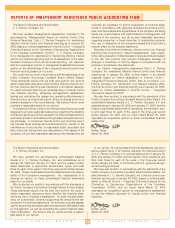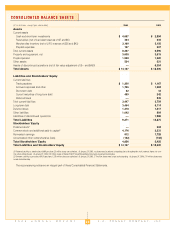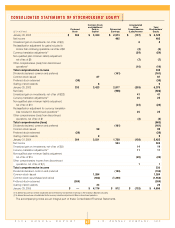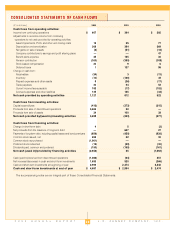JCPenney 2004 Annual Report Download - page 21
Download and view the complete annual report
Please find page 21 of the 2004 JCPenney annual report below. You can navigate through the pages in the report by either clicking on the pages listed below, or by using the keyword search tool below to find specific information within the annual report.
J.C. PENNEY COMPANY, INC.2 004 ANNUAL REPORT
Management’s Discussion and Analysis of Financial Condition and Results of Operations
19
inventories are taken at least annually for all department stores, store
distribution centers, warehouses and Catalog/Internet fulfillment cen-
ters on a staggered basis throughout the year, and inventory records
are adjusted accordingly. The shrinkage rate from the most recent
physical inventory, in combination with current events and historical
experience, is used as the standard for the shrinkage accrual rate for
the next inventory cycle.
To estimate the effects of inflation/deflation on ending inventory, an
internal index measuring price changes from the beginning to the
end of the year is calculated using merchandise cost data at the item
level.
Valuation of long-lived assets:
Management evaluates recoverability of long-lived assets when-
ever events or changes in circumstances indicate that the carrying
value may not be recoverable, for example, when a store’s perform-
ance falls below minimum Company standards. In the fourth quar-
ter of each fiscal year, management reviews the performance of indi-
vidual stores. Underperforming stores are selected for further eval-
uation of the recoverability of the carrying amounts. If the evaluation
indicates that the carrying amount of the asset may not be recover-
able, the potential impairment is measured as the excess of carrying
value over the fair value of the impaired asset. Management esti-
mates fair value based on a projected discounted cash flow method
using a discount rate that is considered to be commensurate with the
risk inherent in the Company’s current business model. Additional
factors are taken into consideration, such as local market conditions,
operating environment, mall performance and other trends.
Impairment losses totaling $12 million, $26 million and $47 million
in 2004, 2003 and 2002, respectively, were recorded for underper-
forming department stores and underutilized Catalog/Internet and
other facilities. If different assumptions were made or different mar-
ket conditions were present, any estimated potential impairment
amounts could vary from recorded amounts.
Reserves and valuation allowances:
Based on an overall analysis of store performance and expected
trends, management periodically evaluates the need to close under-
performing stores. Reserves are established at the point of closure
for the present value of any remaining operating lease obligations
(PVOL), net of estimated sublease income, and at the point of deci-
sion for severance and other exit costs, as prescribed by SFAS No.
146, “Accounting for Costs Associated with Exit or Disposal
Activities.” See further discussion in Note 1 on page 33. Two key
assumptions in calculating the reserve include the timeframe expect-
ed to terminate lease agreements and estimations of other related
exit costs. If different assumptions were used regarding the timing
and potential termination costs, the resulting reserves could vary
from recorded amounts. Reserves are reviewed periodically and
adjusted when necessary.
The Company records a provision for workers’ compensation and
general liability risk based on independent actuarial best estimates
of claims that have been reported, as well as those incurred but not
yet reported, resulting from historical experience and current data.
Total estimated claim amounts are discounted using a risk-free rate.
The actuary provides a range of estimated liability and the Company
targets the provision above the midpoint of that range.
Income taxes are estimated for each jurisdiction in which the
Company operates. This involves assessing the current tax expo-
sure together with temporary differences, which result from differing
treatment of items for tax and book purposes. Deferred tax assets
and liabilities are provided for based on these assessments.
Deferred tax assets are evaluated for recoverability based on esti-
mated future taxable income. To the extent that recovery is deemed
unlikely, a valuation allowance is recorded. Deferred tax liabilities are
provided for when the Company considers that it is probable that
taxes will be due. Deferred liabilities are evaluated and adjusted as
appropriate, considering the progress of audits of various taxing
jurisdictions. Management does not expect the outcome of tax
audits to have a material adverse effect on the Company’s financial
condition, results of operations or cash flow. Many years of data
have been incorporated into the determination of tax reserves and
the Company’s estimates have historically been reasonable.
The Company is involved in legal proceedings and governmental
inquiries associated with employment and other matters. Reserves
have been established based on management’s best estimates of
the Company’s potential liability in these matters. This estimate has
been developed in consultation with in-house and outside counsel.
Management does not believe that these proceedings and inquiries,
either individually or in the aggregate, will have a material adverse
effect on the Company’s consolidated financial position, results of
operations or cash flow. See further discussion in Note 20.
Reserves for potential environmental liabilities related to facilities,
most of which the Company no longer operates, are adjusted based
on the Company’s experience, as well as consultation with inde-
pendent engineering firms and in-house legal counsel, as appropri-
ate. Management continues to believe the reserve is adequate to
cover estimated potential liabilities.
Pension:
Pension accounting
— The Company sponsors a non-contributo-
ry qualified defined benefit pension plan (the primary pension plan),
supplemental retirement plans for certain management associates
and other postretirement benefit plans. Refer to Note 17 for further
discussion of these plans. Major assumptions used in accounting for
these plans include the expected long-term rate of return on plan
assets and the discount rate. Assumptions are determined based
on Company information and market indicators and are evaluated at
each annual measurement date (October 31). A change in any of
these assumptions would have an effect on the Company’s pension
and other postretirement benefit plan costs. These assumptions
require significant judgment, and the calculation of pension costs is
relatively complex. The Company utilizes third parties, including
actuarial and investment advisory firms, to help evaluate annually the
appropriateness of the expected rate of return, the discount rate and
other pension plan assumptions. The following discussion relates to
the primary pension plan only, as it makes up the majority of record-
ed pension expense and related asset/liability amounts in the con-
solidated financial statements.


